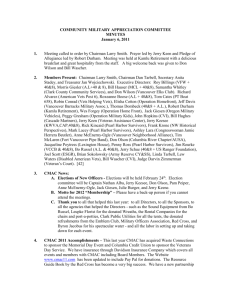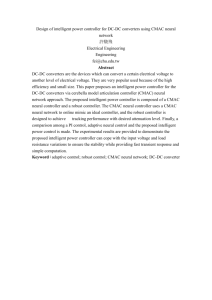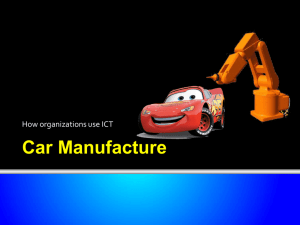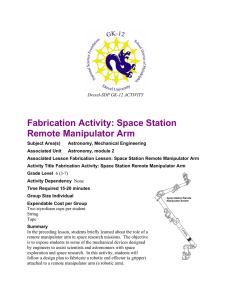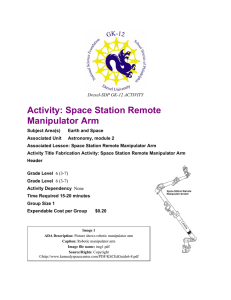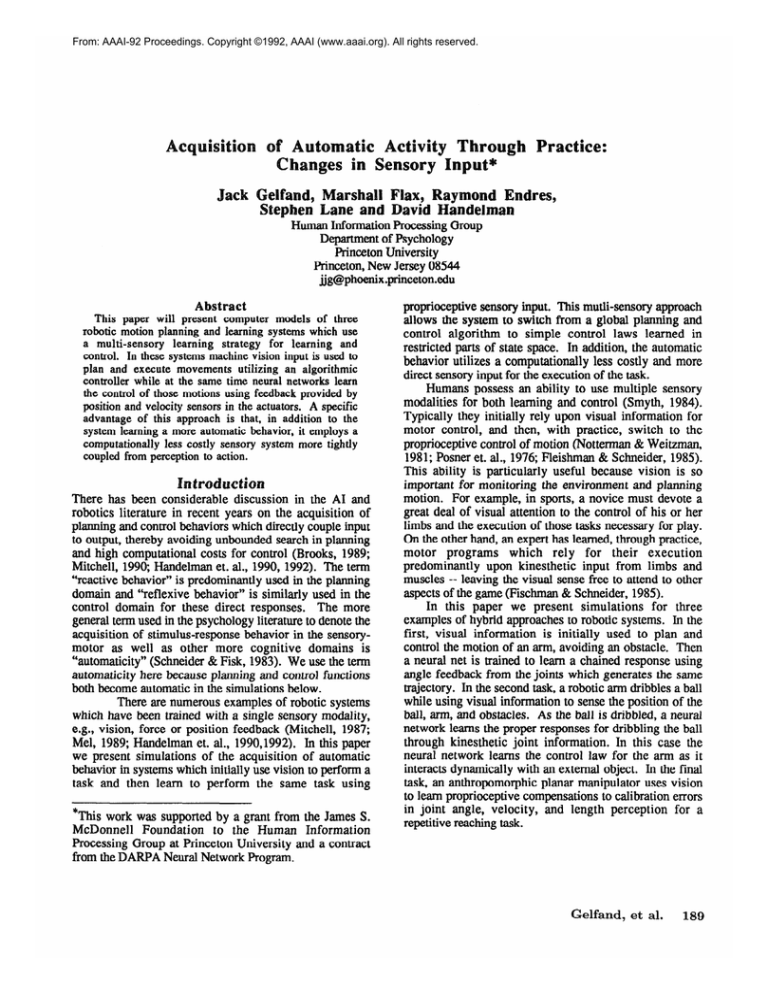
From: AAAI-92 Proceedings. Copyright ©1992, AAAI (www.aaai.org). All rights reserved.
I-hman Information Processing Group
Department of Psychology
Princeton University
Princeton, New Jersey 08544
jjg@phoenix.princeton.edu
Abstract
This paper will present computer models of three
robotic motion planning and learning systems which use
a multi-sensory
learning strategy for learning and
control. In these systems machine vision input is used to
plan and execute movements utilizing an algorithmic
controller while at the same time neural networks learn
the control of those motions using feedback provided by
position and velocity sensors in the actuators. A specific
advantage of this approach is that, in addition to the
system learning a more automatic behavior, it employs a
computationally less costly sensory system more tightly
coupled from perception to action.
There has been considerable
discussion in the AI and
robotics literature in recent years on the acquisition of
planning and control behaviors which directly couple input
to output, thereby avoiding unbounded search in planning
and high computational costs for control @rooks, 1989;
Mitchell, 1990; Handelman et. al., 1990, 1992). The term
“reactive behavior” is predominantly used in the planning
domain and “reflexive behavior” is similarly used in the
control domain for these direct responses.
The more
general term used in the psychology literature to denote the
acquisition of stimulus-response
behavior in the sensorymotor as well as other more cognitive
domains is
“automaticity” (Schneider & Fisk, 1983). We use the term
automaticity here because planning and control functions
both become automatic in the simulations below.
There are numerous examples of robotic systems
which have been trained with a single sensory modality,
e.g., vision, force or position feedback (Mitchell, 1987;
Mel, 1989; Handelman et. al., 1990,1992). In this paper
we present simulations of the acquisition of automatic
behavior in systems which initially use vision to perform a
task and then learn to perform the same task using
*This work was supported by a grant from the James S.
McDonnell
Foundation
to the I-Iuman Information
Processing Group at Princeton University and a contract
from the DARPA Neural Network Program.
proprioceptive sensory input. This muth-sensory approach
allows the system to switch from a global planning and
control algorithm to simple control laws learned in
restricted parts of state space. In addition, the automatic
behavior utilizes a computationally
less costly and more
direct sensory input for the execution of the task.
Humans possess an ability to use multiple sensory
modalities for both learning and control (Smyth, 1984).
Typically they initially rely upon visual information for
motor control, and then, with practice, switch to the
proprioceptive control of motion (Notterman & Weitzman,
1981; Posner et. al., 1976; Fleishman & Schneider, 1985).
This ability is particularly useful because vision is so
important for monitoring the environment and planning
motion. For example, in sports, a novice must devote a
great deal of visual attention to the control of his or her
limbs and the execution of those tasks necessary for play.
Qn the other hand, an expert has learned, through practice,
motor
programs
which rely for their execution
predominantly
upon kinesthetic
input from limbs and
muscles -- leaving the visual sense free to attend to other
aspects of the game (Fischman & Schneider, 1985).
In this paper we present simulations
for three
examples of hybrid approaches to robotic systems. In the
first, visual information
is initially used to plan and
control the motion of an arm, avoiding an obstacle. Then
a neural net is trained to learn a chained response using
angle feedback from the joints which generates the same
trajectory. In the second task, a robotic arm dribbles a ball
while using visual information to sense the position of the
ball, arm, and obstacles. As the ball is dribbled, a neural
network learns the proper responses for dribbling the ball
through kinesthetic joint information.
In this case the
neural network learns the control law for the arm as it
interacts dynamically with an external object. In the final
task, an anthropomorphic planar manipulator uses vision
to learn proprioceptive compensations to calibration errors
in joint angle, velocity, and length perception
for a
repetitive reaching task.
Gelfand,
et al.
189
Visual
introduced by Albus, is particularly
well suited as a
function approximator for the performance of this control
task (Albus, 1975; Lane et. al., 1992). The CMAC was
trained to control the position of the manipulator as a
function of joint angle. During the training passes, the
RMS distance from the visually controlled manipulator
position to the position suggested by the CMAC is
monitored and determines when the CMAC has adequately
learned the desired trajectory.
When the CMAC is
sufficiently trained, the execution monitor then switches
from the visual controller to the kinesthetic controller.
Information
Figure 1. A schematic diagram of a hybrid
learning and control system. This system plans
and executes the motion of an arm using visual
input and trams the arm to perform the task using
feedback from position sensors in the actuators.
A Hybrid Learning
and Control System
A schematic diagram of the system that was used in the
fist two simulations reported here is shown in Fig. 1. A
robot manipulator
is shown performing a task with a
machine
vision
system
initially
determining
the
appropriate trajectory of the manipulator based on relevant
information about the work space. This visual information
is fed to the modules marked kinematic control and visual
control. The visual control module utilizes visual feedback
of the position of the arm to execute movement along the
planned path. During the execution of this visually guided
motion, sensors provide information
about the arm’s
position to a CMAC neural network. (Albus, 1975) This
network is trained to provide the proper control outputs to
cause the arm to move in the same path as under visual
system control.
The process described above is supervised by an
execution
monitor
responsible
for monitoring
the
perfomxmce of the kinesthetic control system relative to
the visually controlled system and for switching control
The execution monitor also
between the two systems.
monitors the gross performance of the system. If problems
are encountered such as an unexpected collision, control
may be switched back to the visual system, which allows
for more comprehensive diagnostic and planning activity.
Learning
Control of Arm Motion in the
Presence of an Obstacle
In this demonstration, we use a visual system to locate an
object in two dimensional space and to control the motion
of the two link manipulator.
The CMAC neural network,
190
Learning: Robotic
Visual Control
Trial Number
Trial Number
Figure 2a-2b. Diagram of a robotic arm under
visual control training a CMAC neural network to
execute the same trajectory using joint angle
feedback. The graph at the bottom of each figure
depicts the RMS difference between the visual and
CMAC control as discussed in the text. In Fig. 2b
control of the arm has been transferred to the
CMAC.
Referring to Fig. 2, we see a two link manipulator
constrained to a horizontal plane. The arrangement of the
manipulator, the object, and the visual system are shown.
For the sake of this demonstration
we used a simple
binocular visual system which locates the object in space
using the angles from the object to the sensors. The path
was calculated by first determining
a point of closest
approach to the obstacle based on the size of the end
effector. This point and the given initial and final end
effector positions were used to compute a spline function
to represent the desired path. The visual system monitors
the position of the end effector as the motion is controlled
by torques calculated by the inverse dynamics of the arm.
As arm moves along the path, the CMAC is given as
input, the current joint angles and joint velocities, and the
desired joint angles at the end of the segment. The CMAC
is trained to output the required torques at each of the two
joints to produce the desired end effector trajectory. The
training consists of comparing the torque output of the
inverse dynamic controller with that of the CMAC and
training the weights by the standard CMAC learning
en the
algorithm (Albus, 1975; Lane et. al., 1992).
error reaches a predetermined threshold, control is switched
to the CMAC.
The results of this demonstration are shown in Figs.
2a-2b. These figures depict the behavior of the system
after the indicated number of runs. Each training run
consists of a complete sweep of the trajectory from the
initial position to the final position.
In each figure, we
use a thin line to indicate the actual trajectory of the end
effector as controlled by the visual input controller. The
heavy lines are the motion that would result from
commands from the CMAC controller. At the bottom of
each figure, we show the RMS differences of the joint
angles plotted against the number of training runs. In Fig.
2a, the dotted lines from the robot’s binocular visual
sensors to the end effector indicate that the system is under
visual control. We can see that the output of the CMAC
begins to approximate
the desired path.
The RMS
difference becomes smaller and the trajectories depicted by
the light and heavy lines become coincident.
In Fig. 2b,
we show the final performance of the system after control
has been transferred to the CMAC.
CMAC is trained with kinesthetic feedback as its input.
This dribbler is modeled in two dimensions and is shown
in Figs. 3a-3d. The task involves dribbling a ball in the
presence of an obstacle moving at a constant velocity from
left to right. Initially, the planner uses the visual location
of the ball to determine where and when to catch the ball
and push it back towards the floor so as to avoid the
obstacle. This is accomplished by visually observing the
position and velocity of the ball, the position of the
obstacle, and the position of the end effector. While this
visually controlled dribbling is going on, the CMAC is
trained with kinesthetic feedback from the joint angles of
the manipulator.
0
50
100
Number of Dribbles
150
Figure 4. A graph of the relative RMS
positional
difference
between
the visually
controlled end effector position and the suggested
CMAC end effector position during the training of
the dribbler. In this example, control of the arm
was switched to the CMAC after the 125th
dribble.
Diagrams of the simulated
Figure 3a-3d.
basketball dribbler described in text. In Figs. 3a-3b
the vision system is responsible
for both the
control of the arm and for sensing of the obstacle
position. In Figs. 3c-3d the arm is under CMAC
neural network control using joint angle feedback
and the sensing of the obstacle is under visual
control.
In this demonstration the arms of a simulated robot are
depicted dribbling a ball using visual feedback while a
During dribbling, the momentum of the ball interacts
with the impedance of the arm. When the ball strikes the
hand, its momentum will cause the arm to fold upward,
absorbing the impact. The final position of the arm can
therefore be used to compute the velocity vector of the ball
as it impacted the hand. The inputs to the CMAC are the
position at which the ball makes contact with the hand, the
total consequent deflection, and the obstacle’s current
position.
The CMAC is then trained to output the
position at which the end effector should stop in its
downward motion in order to release the ball to continue
towards the floor.
For the sake of simplicity in this
model, the manipulator arm moves in a straight path from
the point of maximum deflection to the point of release.
When the output of the CMAC is sufficiently close to the
visually controlled output, the program switches control
Gelfand,
et al.
191
from the visual system to the CMAC.
the model is shown in Fig. 4.
Learning
The petiormance
of
correction.
When this contribution becomes sufficiently
small, the visual system may be dedicated to another task
without a significant change -m performance.
to Compensate for Perceptual
Calibration Errors
In this demonstration,
we use a visual system to learn
compensations for calibration errors in the proprioception
of a six-link planar manipulator.
Feedback error learning
was used to train a CMAC to dynamically compensate for
misperception of the vector distance from the endpoint of
the manipulator to the desired target (Miyamoto, 1988).
Feedback error learning occurs when a neural net is trained
using the output of a feedback controller operating in
parallel with the neural net. The output of Berkinblit’s
kinematic algorithm was filtered to generate desired joint
angular positions, velocities and accelerations, which in
turn were implemented by a hybrid dynamic controller
composed of a PD controller and an adaptive Splinet trained
using feedback error learning (Berkinblit, 1986, Lane et.
al., 199 1, 1990). This system is described in full detail in
(Gelfand, et. al., 1992).
80%
0
10
20
30
40
Number of Sweeps
50
Figure 6. Percent contribution
of
vision to endpoint correction in response to two
perturbations in the calibration of proprioceptive
sensors and link lengths.
Discussion
Figure 5. A diagram of
REACHER as it moves from
final posture. The heavy lines
posture of the manipulator.
indicates the path generated
algorithm for the manipulator.
the movement of
the original to the
indicate the starting
The curved line
by the Berkinblit
Fig. 5 shows the six link planar manipulator in the
initial position with the end effector trajectory to the target.
In this experiment we perturbed the perception of joint
angles and velocities randomly with a maximum amplitude
of f.05 rad. and f.02 rad./s respectively.
In addition, we
perturbed the lengths of the links by up to flcm.
For
comparison, the robot stands approximately lm high. We
began with a system with no sensor errors and then
perturbed the calibrations and joint lengths twice, once after
5 sweeps and once after 30 sweeps. Fig. 6 displays the
contribution
of the vision system to the endpoint
192
Learning:
Robotic
The results described in this paper illustrate a powerful
behavioral strategy used by intelligent biological systems
to cope with a myriad of sensory input and control
responsibilities.
The functionality of present day machine
vision systems is near the limit of their ability to
contribute
to the complex
analysis
of the robotic
Strategies
which
offload
sensory
environment.
responsibilities to other sensor systems make it possible to
utilize vision systems for those tasks for which they are
more qualified.
Finally, we should be aware that we learn multiple
cues for the execution of learned tasks, some of which may
not be apparent when we start.
These cues include
information
from our auditory system, somatosensory
system and other senses in addition
to sight and
kinesthesis. Intelligent robotic control systems of the kind
described here should really measure the correlations among
sensory inputs and pick those which provide the maximum
sensitivity for the control of learned actions. As Mitchell
points out, this is becoming “increasingly
perceptive.”
(Mitchell, 1990; Tan, 1990.)
Acknowledgements
This work was largely inspired by discussions with David
Touretzky and Joseph Notterman.
We also acknowledge
helpful discussions with Lorraine Crown.
References
Albus, J. 1975. A New Approach to Manipulator Control:
ode1 Articulation Controller (C
C). J.
Byn. Syst. Meas. and Cont. 97~270-277.
Berkinblit, M.V.; Gel’fand, I.M.; and Feldman,
1986. Model of the Control of the Movements
Multijoint Limb. Neural Networks 3 l(1): 142-153.
A.G.
of a
Fischman, M. G. and Schneider, T. 1985. Skill Level,
Vision, and Proprioception in Simple One Hand Catching.
J. Mot. Behavior 17~219-229.
Fleishman, E. A. and Rich, S. 1963. Role of Kinesthetic
and Spatial-Visual Abilities in PerceptualJ. Exptl. Psychology 66:6-l 1.
Gelfand J.J.; Flax M.G.; Endres R.E.; Lane S.H.; and
Handelman D.A. 1992. Multiple Sensory Modalities for
Learning and Control, in Venkataraman, S.T. and Gulati,
S., eds., Perceptual Robotics, Springer-Verlag, New York.
Forthcoming.
Handelman, D.A.; Lane, S.H.; and Gelfand, J.J. 1990.
Integrating Neural Networks and Knowledge-Based Systems
for Intelligent Robotic Control. IEEE Control Systems
Magazine 10(3):77-87.
Handelman, D.A.; Lane, S.H.; and Gelfand, J.J. 1992.
Robotic Skill Acquisition Based on Biological Principles.
In Kandel, A. and Langholz, G., e&., Hybrid Architectures
for Intelligent Systems, CRC Press, Boca Raton, Fla.,
301-328.
Mitchell, T. 1990. Becoming Increasingly Reactive.
In
Proceedings of AAAI-90, 1051-1058. Boston, August,
1990, American Association for Artificial Intelligence,
Menlo Park, Ca..
Miyamoto, H.; Kowato, M.; Setoyama, T.; and Suzuki,
R. 1988. Feedback Error Learning Neural Network for
Trajectory Control of a Robotic Manipulator.
NeuraZ
Networks 1~251-265.
Notterman, J. M. and Weitzman, D. 0.1981. Organization
and Learning of Visual-Motor Information During Different
Orders of Limb Movement: Step, Velocity, Acceleration.
J. Exp. Psych.: Human Perception and Performance
7~916-927.
Posner, M. I.; Nissen, M.J.; and Klein, R.M. 1976.
Visual Dominance: an Information Processing Account of
its origin. Psychology Review 83:157-171.
Schneider, W. and Fisk, A. 1983. Attention Theory and
Mechanisms for Skilled Performance.
In Magill, R., ed.,
Memory and The Control of Action, North-Holland
Publishing, Amsterdam, 119-143.
Smyth, M. M. 1984. Perception and Action. In Smyth,
M. M., and Wing, A. M., eds., The Psychology of Human
Movement, Academic Press, New York, 119-15 1.
Tan, M. 1990. A Cost-Sensitive
Learning System for
Sensing and Grasping Objects.
Proc. IEEE Conf. on
Robotics and Automation, 858-863. Los Alamitos: IEEE.
Lane, S.; Handelman, D.; and Gelfand J. 1992. Theory and
Development of Higher Order CMAC Neural Networks.
IEEE Control Systems Magazine 12(4). Forthcoming.
Lane, S.H.; Flax, M.G.; Handelman, D.A.; and Gelfand,
J.J. 1991.
Multi-Layer
Perceptrons
with B-Spline
Receptive
Field Functions.
In Advances
in Neural
Information Processing Systems III. San Mateo, Ca.:
Morgan Kaufmann, 684-692
Lane, S.H.; IIandelman, D.A.; and Gelfand, J.J. 1990. Can
Robots Learn Like People Do? In Rogers, S., ed,
Applications of Artificial Neural Networks, kx. of the
SPIE, 1294:296-309.
Mel, B. 1989. Further Explorations in Visually-Guided
Reaching: Making Murphy Smarter.
In D. Tourtetzky,
ed., Advances in Neural Information Processing Systems I.
San Mateo, Ca.: Morgan Kaufmann 348-355.
Miller, W. T. 1987. Sensor Based Control of Robotic
Manipulators
Using a Generalized Learning Algorithm
IEEE J. Rob. and Automat. 3:157-165.
Gelfand,
et al.
193

